Zoltán Kiss- Area Sales Manager - East Europe - Endrich GmbH.
SPC and ES energy storage systems – EVE Battery
8 May 2015

Summary :
Electronics devices which are designed for applications that require short term operation and stay long be in stand-by mode usually need huge energy impulse immediately after wake-up command. These can be emergency alarm systems, RFID transponders, GPS tracking devices, smart meters’ read-out electronics or the recently obliged E-CALL systems of passenger vehicles. A stabile voltage, low leakage current battery is required, that can pump huge momentary charge in a short time into the system. These requirements are often realized by integrating different super-capacitors, that have ten or even hundred times higher energy density than normal electrolytic capacitors, their charge and discharge times are also shorter, and tolerate much more cycles that e.g. rechargeable batteries. Supercap’s operation is usually based on electrostatic principle, however there are some special devices, like EVE Energy’s own patented SPC devices, that are featured by chemical working principle They usually do not operate alone, but as a part of one of EVE’s energy storage systems, which is in fact a special battery pack. This paper introduces the advantages of such system.
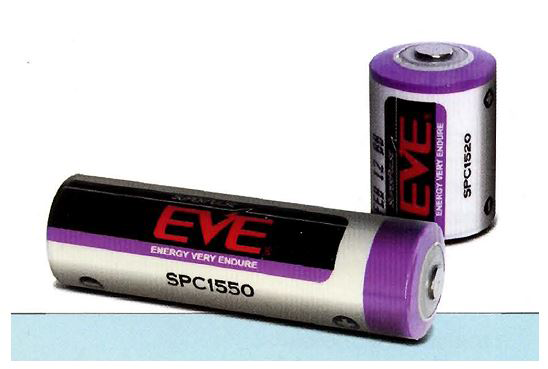
SPC device

The super pulse capacitors produced by EVE are momentary high-current discharge devices that can operate in the operational temperature range of -40°C to +85°C. SPC’s unique chemical lithium structure is based on EVE’s own patents. The hermetically closed and sealed enclosure with safety valves makes the design superior safe even in applications where traditional super-capacitors cannot be used. One of this areas is the gas metering, where SPC with its ATEX approval is an ideal solution for energizing smart-meter’s readout, as the safety valves make the device explosion proof.
The cell voltage is 3.6V, and no passivation appears, which other lithium battery families are suffering from. The self discharge remains under 2%, which makes it possible to stay long in stand-by more and activate fast to pump momentary large charge into the circuit.
If a smart meter contains a standalone ER (lithium thionyl chloride) battery, the voltage delay caused by the passivation effect may cause problem in operation. Passivation is a phenomenon of lithium primary cells related to the interaction of the lithium metal anode and the electrolyte. A thin so called passivation layer forms on the surface of the anode at the moment the electrolyte is injected into the cell during production. This layer is important because it protects the anode from reaction while the cell is not affected by load, resulting in a long shelf-life. Under load, when battery starts to discharge, the current flowing through the cell will start to rebuilt this layer. Under normal conditions, the thin passivation layer does not affect or degrade the performance of the battery cell. When the layer grows too thick due to long storage, discharge performance may be affected. The development of the passivation layer is influenced by the conditions of the storage, long unloaded periods of months or years and keeping the cells above room temperature (23-25 oC) will cause the passivation layer to grow thicker. A passivated cell may show voltage delay when suddenly applied under load, the voltage response is delayed. In such cases a smart utility meter - being in stand by for a long period of time - will not operate perfectly, the readout electronics may not start and the data transfer may fail. A possible solution for such cases to use an SPC device in addition to the ER battery.
Combined solution: EVE ES energy storage systems
EVE’s SPC is a standalone device, however on the field it is often used in combination with ER cells, which are responsible for providing enough capacity. By connecting the two cells in parallel, the lithium metal primary battery will keep the SPC fully charged. EVE’s ES battery packs are formed by an SPC and a lithium thionyl-chloride (Li-SOCl2) battery as seen on the figures:
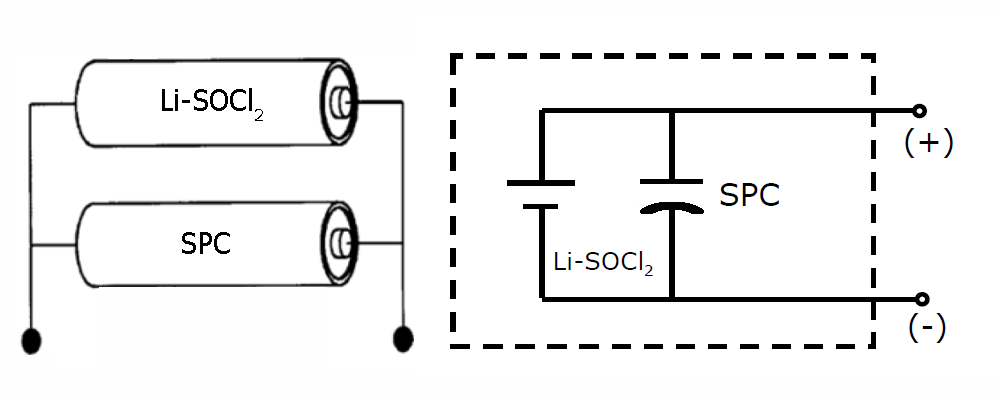
Of curse there are different combinations by means of number of ER cells behind the SPC, or using even more SPC devices in the same time:
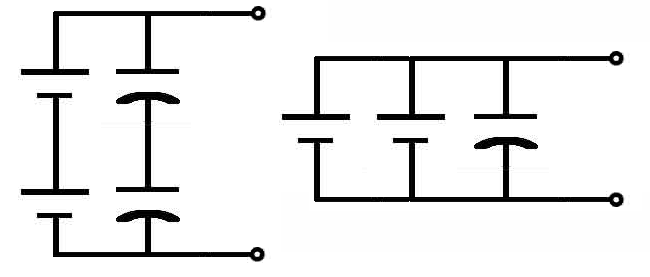
Lithium thionyl chloride cells have a metallic lithium carbon - the lightest of all the metals – anode and a liquid cathode comprising a porous current collector filled with thionyl chloride (SoCl2). They deliver a nominal voltage of 3.6V, their open circuit voltage is 3,66V and during load with their 3.4-3,6V closed circuit voltage they are one of market’s highest voltage primer cells. Lithium thionly chloride batteries are the primary battery currently with the highest voltage and energy density (1280 Wh/dm3), longest storage (10-20 years) , and the least self-discharge rate of 1%@20OC. The battery is capable of operation in a wide temperature range normally from -60°C~+85°C. Those batteries are ideal for such long-term applications as power for electric devices and electric power, water, heat and gas meters, and especially as backup power source for memory ICS. There are larger pulse current spiral types as well as higher capacity bobbin cells in the program. The bobbin type is safer, however usually it has a voltage delay and its pulse capability may be not enough to supply momentary large current to the device (passivation).
Marrying the SPC and the bobbin type ER technologies, we can combine the advantages. Litium primer battery will store enough capacity and keeping SPC fully charged all the time, while SPC device is able to pump pulse charge fast to the system. Other manufacturers combine ER batteries with super capacitors, in comparison of the two technologies, the lithium chemistry based SPC systems offer the following advantages:
- Higher cell voltage ( 3,6V vs max 2,7V)
- Much smaller impedance ( <150 mOhm vs cca 400 mOhm)
- Higher capacity( >270F vs max 100F)
- Much higher energy density
- By orders of magnitude less leakage current, which is even almost independent from temperature, saving ER battery life (<1uA)
- Much wider operating temperature range
- Much longer service life ( cca 15 years)
- Much safer battery pack( UL1642 UN 38.3)
The figure shows, that fast charge pumping of the SPC covers the voltage delay caused by passivation of Li/SOCl2 cell, and the pack voltage never goes below the working voltage of the device. The measurement has been done by using 10 mA continuous load current with a pack formed by an ER14250 battery and an SPC1520 energy storage system.
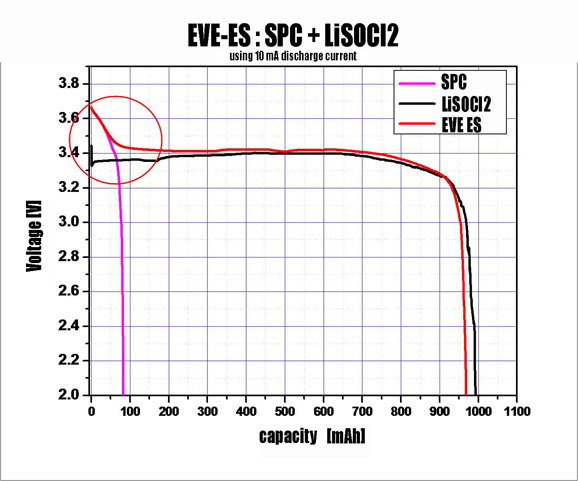
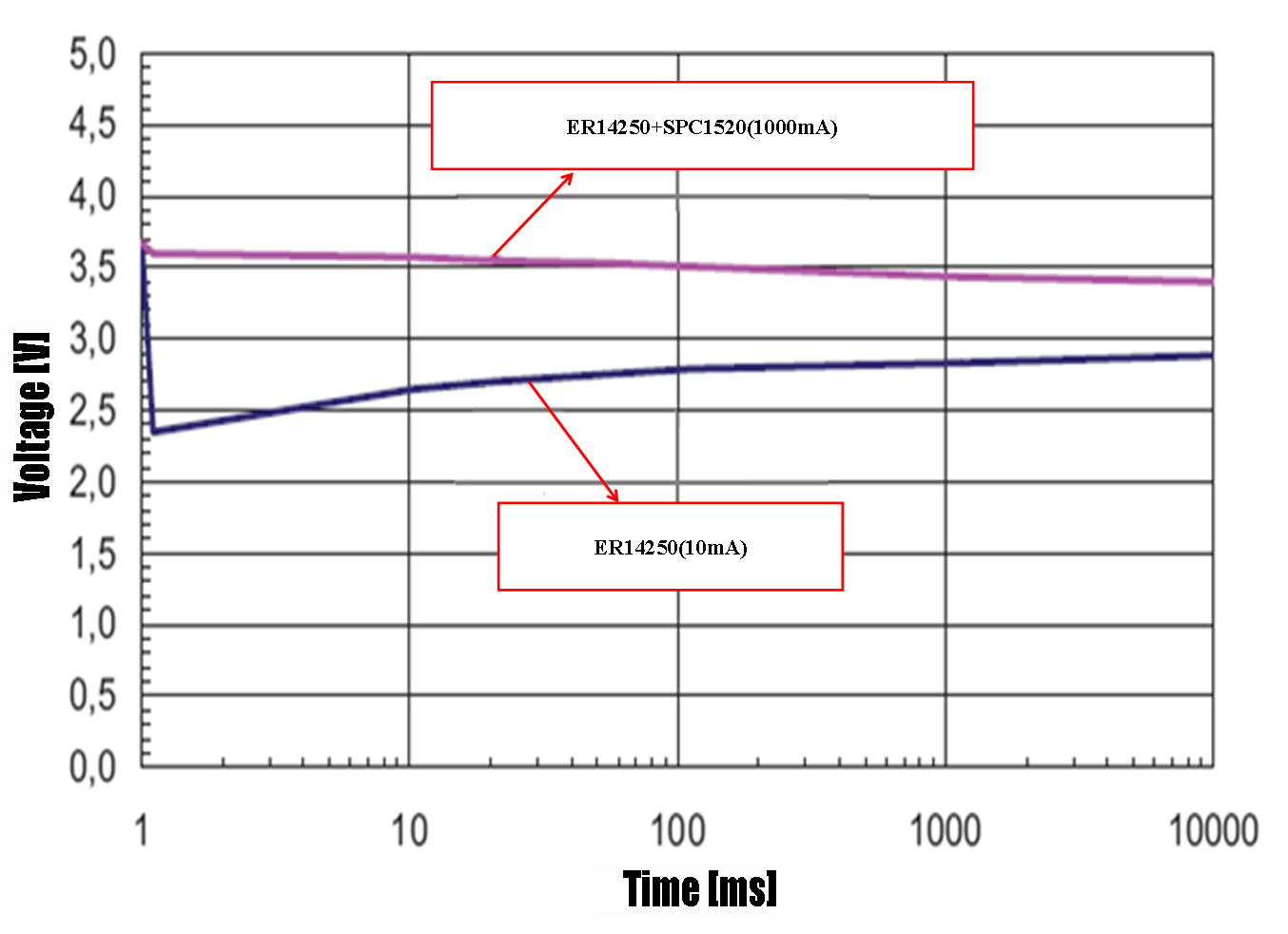
Other measurement show that the leakage current of the EVE ES system at -30°C stays under 2uA, at +25°C stays under 1uA while at +85°C it will be still below 5uA, therefore considered to be stabile independent from ambient temperature. Lifetime expectation can reach 10-15 years, the pack is able to provide as high as 1A of pulse current, due to its safe construction it can be used in sensitive environment (ATEX). The combined product successfully provides solution for both high energy density (large capacity) and high power density (high momentary current) requirements.

| Share on Facebook | Share on LinkedIn |
References
This article has been published on the following locations:
| # | Media | Link |
|---|---|---|
| 1 | Elektronet 2015/4 | Elektronet : elektronikai informatikai szakfolyóirat, 2015. (24. évf.) 4. sz. 25-26. old. |
| 2 | Elektronet online | Energiatároló rendszerek az EVE Energy-től |
| 3 | Hungarian version | SPC és ES energiatároló rendszerek - EVE battery |
| 4 | TechStory M2M | SPC és eldobható lítiumelem együttes alkalmazása |
| 5 | South-East European Industrial Market 2017/3 | SPC and ES Energy Storage Systems |
| 6 | Revista Española de Electrónica | Sistemas de almacenamiento de energía ES y SPC (supercondensador de impulsos) de EVE Energy en las filas de Endrich |


